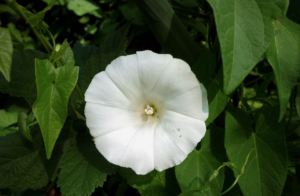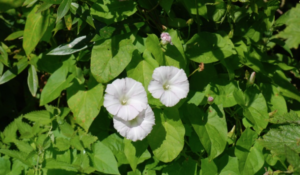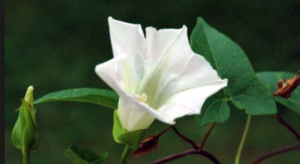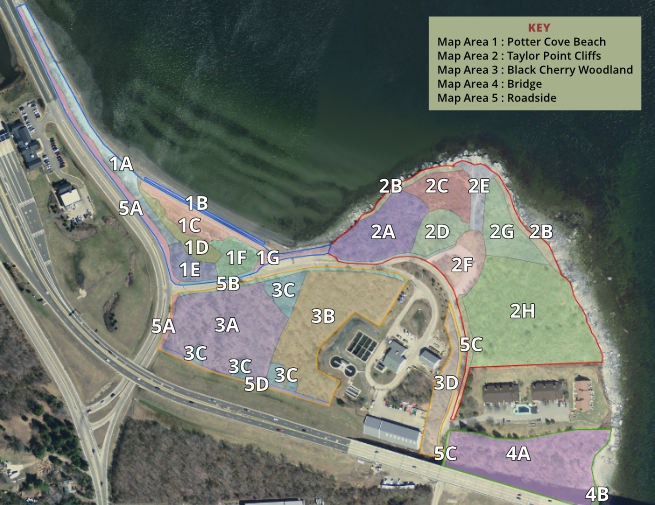Common Name: Hedge Bindweed
Specific Name: Calystegia sepium
Known Occurrence at Taylor Point:
Map Areas: Beach 1A
Category: Native, Herbaceous Plant

Ecological Considerations:
Calystegia sepium, commonly known as Hedge Bindweed is a perennial herbaceous vine that grows up to 10′ long, often climbing over other plants, shrubs, and fences. The twining stems are light green to red, with alternate leaves sparsely to moderately distributed along the stems. The leaves are about 2½-5″ long and 1-2″ across and their margins are smooth and slightly ciliate. The upper leaf surface is medium green while the lower leaf surface is light green. The large buds produce flowers with funnelform corollas that are 2-3″ across and similarly long; they are slightly 5-lobed. These corollas are usually white, although sometimes they are pale pink with spreading white stripes. However, deep within the flowers, the corollas are yellow.
While Hedge Bindweed blooms intermittently during the summer from July through August, individual flowers last only a single day. After they bloom, the flowers are replaced by broadly ovoid seed capsules the are about ½” across. At maturity, these capsules split open and release the 2 – 4 dull brown to black seeds within each capsule. These seeds have two flat sides & one rounded side and are less than ¼ inch long.
The root system of Hedge Bindweed is fibrous and rhizomatous, and may extend into the ground up to 10′. The plant prefers full to partial sun and moist to mesic conditions. It grows well on disturbed habitats, tolerates poor soil and grows well in sandy and gravelly environments. It grows well alongside brackish or salt marshes and flats, on coastal beaches (sea beaches), and in marshes, meadows and fields, as well as on wetland margins and atop seaweed heaps. In open areas it sprawls haphazardly across the ground.
Map areas where this plant can be used for revegetation:
Propagation Mechanisms/Strategies for Encouraging its Establishment:
Hedge Bindweed spreads by clonal offshoots from its rhizomes or by reseeding itself.
Best Planting Practices/Options and Pros and Cons of Options:
Key Issues Regarding its Ecology:
Associated Ecological Benefits:
Long-tongued bees are the primary pollinators of the Hedge Bindweed flowers. It is likely that day-flying Sphinx moths visit the flowers during the morning seeking nectar from the flowers. Several species of tortoise beetles also feed on the foliage of Hedge Bindweed.
Availability of Locally Sourced Seeds and Plants:
Case Studies of Native Plant Establishment Efforts/Lessons Learned:
Additional Photos:


Sources cited:
Illinois Wildflowers
Go Botany
Nature Gate
Key Words:
Calystegia sepium
Hedge Bindweed
Beach 1A
